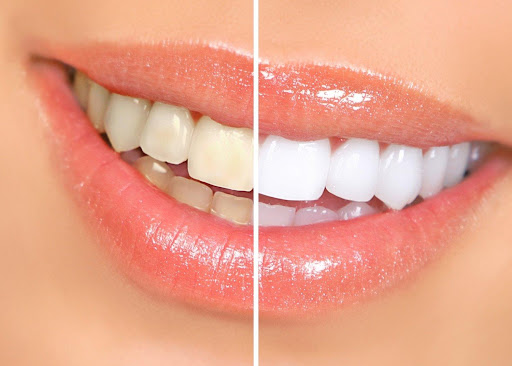Do you ever look in the mirror and feel self-conscious about your teeth? It can be embarrassing to have discolored teeth, but many people don’t realize that there are numerous causes of tooth discoloration.
In this blog post, we will discuss the different causes of tooth discoloration and how you can improve the appearance of your teeth. Keep reading to learn more!
What is Tooth Discoloration?
Tooth discoloration is when the tooth loses its original color and becomes darker or lighter.
Many factors can influence tooth discoloration, including certain foods and drinks, smoking, medications, and aging. While tooth discoloration is usually a cosmetic issue, it can also signify more serious dental problems.
If you are concerned about tooth discoloration, consult your dentist for an assessment. In most cases, tooth discoloration can be treated with professional and at-home teeth whitening treatments.
Types and Causes of Teeth Discoloration and Stains
Tooth discoloration is not unusual and can be caused by many things. The enamel on our teeth is porous, so it’s normal for them to absorb some of the food and drinks we consume daily.
There are two types of tooth discoloration: extrinsic and intrinsic.
Extrinsic Stains
Extrinsic stains develop on the tooth’s surface and are typically easier to remove than intrinsic stains.
Extrinsic tooth discoloration is usually caused by:
- Certain foods and drinks, such as coffee, tea, and red wine
- Smoking
- Poor dental hygiene
Intrinsic Stains
Intrinsic stains develop below the enamel and are often more difficult to remove. They occur when the tooth itself becomes stained.
Intrinsic tooth stains can be caused by:
- Medications, such as tetracycline antibiotics
- Damage to a permanent tooth, such as from a tooth injury
- Age-related teeth stains, which cause the dentin (the inner layer of the tooth) to yellow
- Genetics, which causes yellow teeth
- Diseases such as dental fluorosis (a condition that results from overexposure to fluoride during tooth development)
Treatment for Tooth Discoloration
There are many teeth whitening options available for tooth discoloration. However, the treatment that’s right for you will depend on the type and severity of the stain.
Sometimes, a simple teeth whitening procedure may be enough to remove extrinsic stains. However, more stubborn stains may require more aggressive treatment, such as veneers or bonding.
Professional Teeth Whitening
Professional teeth whitening is a safe and effective way to brighten your smile. The procedure is usually done in the dentist’s office and can make your teeth several shades lighter.
At-Home Teeth Whitening Kits
At-home teeth whitening kits contain bleaching agents that you apply to your teeth at home. These kits are typically less expensive than professional teeth whitening, but they may not be as effective.
Over-the-Counter Teeth Whitening Products
Many over-the-counter teeth whitening products are available, such as toothpaste, gels, and strips. These products are easily accessible and more affordable than professional teeth whitening treatments.
Dental Veneers
Veneers are thin porcelain shells bonded to the front of your teeth. They can be used to cover up tooth stains and other imperfections.
Dental Bonding
Dental bonding is when a tooth-colored resin is applied to the teeth and hardened with UV light. Bonding can be used to improve the appearance of discolored or stained teeth.
If you’re concerned about tooth discoloration, consult your dentist for an assessment. They will know about the best way to treat it.
Tooth Discoloration Prevention Tips
To keep your smile looking its best, taking care of your teeth and preventing tooth discoloration is important.
While discolored teeth may be due to many different reasons, there are also many ways to prevent it. Here are a few tips:
- Brushing teeth at least twice a day using fluoridated toothpaste: Fluoride helps prevent tooth decay and strengthens tooth enamel, making it less likely to stain.
- Flossing daily: This will also help remove plaque and other food particles that can cause staining.
- Eating a balanced diet and limiting processed foods: A healthy diet will help keep your teeth and gums healthy.
- Limit sugary foods and drinks: Sugary drinks and foods can contribute to tooth decay because sugar promotes the growth of bacteria.
- Quitting smoking and avoiding tobacco products: Smoking and other tobacco products can cause staining and other dental problems.
- Limiting consumption of staining foods and drinks: Limit your intake of coffee, tea, and red wine, as these are teeth-staining beverages. Dark foods are also tooth staining and should therefore be avoided. If you do consume these items, brush your teeth afterward.
- Using a straw when drinking beverages that can cause staining: This will help to avoid contact between the drink and your teeth.
- Visiting the dentist for regular checkups and cleanings: Plaque and tartar build-up can lead to tooth staining, so it’s important to have these removed regularly. Regular dental visits will help ensure that your teeth and gums are healthy.
These simple tips will help you keep your smile looking bright and healthy for years to come!
Related Posts: